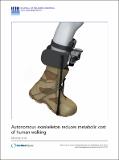| dc.contributor.author | Mooney, Luke M. | |
| dc.contributor.author | Rouse, Elliott J. | |
| dc.contributor.author | Herr, Hugh M | |
| dc.date.accessioned | 2014-11-19T14:01:15Z | |
| dc.date.available | 2014-11-19T14:01:15Z | |
| dc.date.issued | 2014-11 | |
| dc.date.submitted | 2014-08 | |
| dc.identifier.issn | 1743-0003 | |
| dc.identifier.uri | http://hdl.handle.net/1721.1/91609 | |
| dc.description.abstract | Background:
Passive exoskeletons that assist with human locomotion are often lightweight and compact, but are unable to provide net mechanical power to the exoskeletal wearer. In contrast, powered exoskeletons often provide biologically appropriate levels of mechanical power, but the size and mass of their actuator/power source designs often lead to heavy and unwieldy devices. In this study, we extend the design and evaluation of a lightweight and powerful autonomous exoskeleton evaluated for loaded walking in (J Neuroeng Rehab 11:80, 2014) to the case of unloaded walking conditions.
Findings:
The metabolic energy consumption of seven study participants (85 ± 12 kg body mass) was measured while walking on a level treadmill at 1.4 m/s. Testing conditions included not wearing the exoskeleton and wearing the exoskeleton, in both powered and unpowered modes. When averaged across the gait cycle, the autonomous exoskeleton applied a mean positive mechanical power of 26 ± 1 W (13 W per ankle) with 2.12 kg of added exoskeletal foot-shank mass (1.06 kg per leg). Use of the leg exoskeleton significantly reduced the metabolic cost of walking by 35 ± 13 W, which was an improvement of 10 ± 3% (p = 0.023) relative to the control condition of not wearing the exoskeleton.
Conclusions:
The results of this study highlight the advantages of developing lightweight and powerful exoskeletons that can comfortably assist the body during walking. | en_US |
| dc.description.sponsorship | National Science Foundation (U.S.). Graduate Research Fellowship (Award 1122374) | en_US |
| dc.publisher | BioMed Central Ltd | en_US |
| dc.relation.isversionof | http://dx.doi.org/10.1186/1743-0003-11-151 | en_US |
| dc.rights | Creative Commons Attribution | en_US |
| dc.rights.uri | http://creativecommons.org/licenses/by/4.0 | en_US |
| dc.source | BioMed Central Ltd | en_US |
| dc.title | Autonomous exoskeleton reduces metabolic cost of human walking | en_US |
| dc.type | Article | en_US |
| dc.identifier.citation | Mooney, Luke M, Elliott J Rouse, and Hugh M Herr. “Autonomous Exoskeleton Reduces Metabolic Cost of Human Walking.” J NeuroEngineering Rehabil 11, no. 1 (2014): 151. | en_US |
| dc.contributor.department | Massachusetts Institute of Technology. Department of Mechanical Engineering | en_US |
| dc.contributor.department | Massachusetts Institute of Technology. Media Laboratory | en_US |
| dc.contributor.department | Program in Media Arts and Sciences (Massachusetts Institute of Technology) | en_US |
| dc.contributor.mitauthor | Mooney, Luke M. | en_US |
| dc.contributor.mitauthor | Rouse, Elliott J. | en_US |
| dc.contributor.mitauthor | Herr, Hugh M. | en_US |
| dc.relation.journal | Journal of NeuroEngineering and Rehabilitation | en_US |
| dc.eprint.version | Final published version | en_US |
| dc.type.uri | http://purl.org/eprint/type/JournalArticle | en_US |
| eprint.status | http://purl.org/eprint/status/PeerReviewed | en_US |
| dc.date.updated | 2014-11-17T20:03:39Z | |
| dc.language.rfc3066 | en | |
| dc.rights.holder | Luke M Mooney et al.; licensee BioMed Central Ltd. | |
| dspace.orderedauthors | Mooney, Luke M; Rouse, Elliott J; Herr, Hugh M | en_US |
| dc.identifier.orcid | https://orcid.org/0000-0003-1516-0093 | |
| dc.identifier.orcid | https://orcid.org/0000-0003-3169-1011 | |
| mit.license | PUBLISHER_CC | en_US |
| mit.metadata.status | Complete | |
